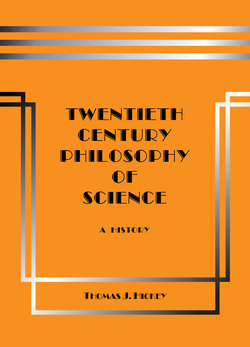Читать книгу Twentieth-Century Philosophy of Science: A History (Third Edition) - Thomas J. Hickey - Страница 23
На сайте Литреса книга снята с продажи.
2.03 Contemporary Pragmatism
ОглавлениеWe are now said to be in a “post-positivist’ era in the history of Western philosophy, but this term merely says that positivism has been relegated to history; it says nothing of what has replaced it. What has emerged in reaction to positivism is a new coherent master narrative appropriately called “contemporary pragmatism”, which was occasioned by reflection on quantum theory, and is currently the ascendant philosophy in American academia.
This new pragmatism had earlier versions in the classical pragmatists, notably those of Charles Peirce, William James and John Dewey. Some theses in classical pragmatism such as the importance of belief have been carried forward into the new.
In contemporary pragmatism belief is strategic, because it controls relativized semantics, which signifies a correspondingly realistic ontology to the degree that a belief is empirically adequate.
Especially important is Dewey’s emphasis on participation and his pragmatic thesis that the logical distinctions and methods of scientific inquiry develop out of scientists’ successful problem-solving processes.
The provenance of the contemporary pragmatist philosophy of science is 1932 Nobel-laureate physicist Werner Heisenberg’s reflections on the language in his quantum-theory revolution in microphysics. There have been various alternative semantics and thus ontologies proposed for the quantum theory. Most physicists today have accepted one that has ambiguously been called the “Copenhagen interpretation”.
There are two versions of the Copenhagen interpretation. Contrary to the alternative “hidden variables” view of David Bohm, both Copenhagen versions assert a thesis called “duality”. The duality thesis is that the wave and particle manifestations of the electron are two aspects of the same entity, as Heisenberg says, rather than two separate entities, as Bohm says.
1922 Nobel-laureate Niels Bohr, founder of the Copenhagen Institute for Physics, proposed a version called “complementarity”. His version says that the mathematical equations of quantum theory must be viewed instrumentally instead of descriptively, because only ordinary discourse and its refinement in the language of classical physics can describe physical reality. Instrumentalism is the doctrine that scientific theories are not descriptions of reality, but are merely useful linguistic instruments that enable correct predictions.
The quantum theory says that the electron has both wave and particle properties, but in classical physics the semantics of the terms “wave” and “particle” are mutually exclusive – a wave is spread out in space while a particle is a concentrated point. Therefore Bohr maintained that description of the electron’s duality as both “wave” and “particle” is an indispensable semantic antilogy that he called “complementarity”.
Heisenberg, a colleague of Bohr at the Copenhagen Institute, proposed his own version of the Copenhagen interpretation. His version also contains the idea of the wave-particle duality, but he said that the mathematical expression of the quantum theory is realistic and descriptive rather than merely instrumental. And since the equations describing both the wave and particle properties of the electron are mathematically consistent, he disliked Bohr’s complementarity antilogy.
Years later Yale University’s Russell Hanson said that Bohr maintained a “naïve epistemology”. Duality is a thesis in physics while complementarity is a thesis in linguistics and philosophy of language. However, the term “complementarity” has since acquired some conventionality to signify duality, and is now ambiguous as to the issue between Bohr and Heisenberg, since physicists typically disregard the linguistic issue.
These two versions of the Copenhagen interpretation differ in their philosophy of language. Bohr’s philosophy is called a “naturalistic” view of semantics, which requires what in his Atomic Physics and the Description of Nature (1934) he called “forms of perception”. Heisenberg’s philosophy is called an “artifactual” or a “conventionalist” view of semantics, in which the equations of the quantum theory supply the linguistic context, which defines the concepts that the physicist uses for observation.
1921 Nobel-laureate physicist Albert Einstein had influenced Heisenberg’s philosophy of language, which has been incorporated into the contemporary pragmatist philosophy of language. And consistent with his relativized semantics Heisenberg effectively practiced ontological relativity and maintained that the quantum reality exists as “potentia” prior to determination by execution of a measurement operation. For Heisenberg indeterminacy is real. For more about Heisenberg and quantum theory the reader is referred to BOOKs II and IV below.
Contemporary pragmatism is a general philosophy for all empirical sciences, both social and natural sciences. The distinctive linguistic philosophy of Einstein and especially Heisenberg as incorporated into the contemporary pragmatist philosophy of science can be summarized in three theses, which may be taken as basic principles in contemporary pragmatism:
